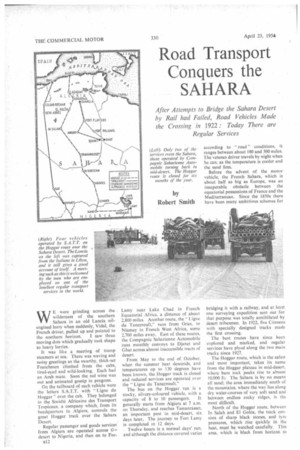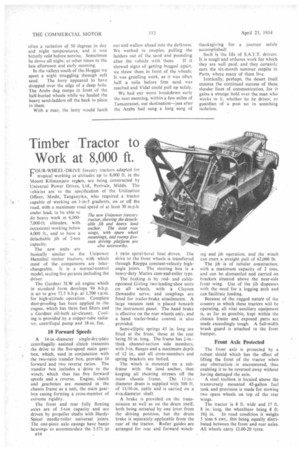Road Transport Conquers the SAHARA
Page 46

Page 47

Page 48

If you've noticed an error in this article please click here to report it so we can fix it.
WE were grinding across the wilderness of the southern Sahara in an old Lancia oilengined lorry when suddenly, Vidal, the French driver, pulled up and pointed to
the northern horizon. I saw three moving dots which gradually took shape as heavy lorries.
It was like a meeting of tramp steamers at sea. There was waving and noisy greetings as the swarthy, thick-set Frenchmen climbed from the cabs, tired-eyed and wild-looking. Each had an Arab mate. Soon the red wine was out and animated gossip in progress.
On the tailboard of each vehicle were the letters S.A.T.T. with " Ligne du Hoggar" over the cab. They belonged to the Societe Africaine des Transport Tropicaux, a company which, from its headquarters in Algiers, controls the great Hoggar track over the Sahara Desert.
Regular passenger and goods services from Algiers are operated across tl.P. desert to Nigeria, and then on to Fort al2
Lamy near Lake Chad in French Equatorial Africa, a distance of about 2,800 miles. Another route, the Ligne du Tanezrouft," runs from Oran, to Niamey in French West Africa, some 2,700 miles away, East of these routes, the Compagnic Saha rienne Automobile runs monthly convoys to Djanet and Ghat across almost inaccessible tracts of desert.
From May to the end of October, when the summer heat descends, and temperatures up to 130 degrees have been known, the Hoggar (rack is closed and reduced services are operated over the " Ligne du Tanezrouft."
The bus on the Hoggar run is a stocky, silvery-coloured vehicle, with a capacity of 8 to 10 passengers. It generally starts from Algiers at 7 a.m. on Thursday, and reaches Tamanrasset, an important post in mid-desert, six days later, The journey to Fort Lamy is completed in 12 days.
. Twelve hours is a normal days' run. and although the distance covered varies bridging it with a railway, and at least one surveying expedition sent out for that purpose was totally annihilated by desert tribesmen. In 1922, five Citroens with specially designed tracks made the first crossing.
The best routes have since been explored and marked, and regular services have plyed along the two main tracks since 1927.
The Hoggar route, which is the safest and most important, takes its name from the Hoggar plateau in mid-desert, where bare rock peaks rise to almost 10,000 ft: The Sahara is by no means all sand; the area immediately south of the mountains, where the way lies along dry water-courses of very soft sand and between endless rocky ridges, is the most difficult.
North of the Hoggar route, between In Salah and El Golea, the track consists of sharp black stones, and tyre pressures, which rise quickly in the heat, must be watched carefully. This area, which is black from horizon to
horizon, presents an unearthly picture under the grilling sun.
Small cairns mark the routes in the stony areas and lorry tracks in the sand. After a sandstorm, however, the way may be difficult to follow, although there are oil-drums, sunk like buoys in the sand, spaced at reasonable distances. Anyone uncertain of the way, or who suffers the misfortune of a breakdown, should stop and wait, for it is fatal to wander away from the track.
S.A.T.T. maintain posts of various sizes along the route; some are in thriving oases, others are tiny mud forts manned by a Frenchman and a couple of Arabs. They are roughly 250 miles apart, and are in radio communication so that departures can be signalled to the next post.
The independent driver has to enter into a breakdown contract with S.A.T.T. before he is allowed to set out over the Sahara. This will cost him about £60, which is refunded if he gets through without having to call on the rescue services. The contract covers the rescue of people only, not the vehicle and luggage.
His vehicle will be inspected before the contract is signed, and high ground clearance and wide-section low-pressure tyres are important. There must be shovels and sand-ladders or planks for getting out of soft sand, and a reasonable number of spares. Radiators. springs, and tyres are especially vulnerable. A fuel capacity of 120 gallons. 5 to 10 gallons of water per person. and food for 30 days, are officially recommended.
"Get there as soon as you can." seems to be the rule for S.A.T.T. vehicles. When I went to the company's office in Nigeria seeking a passage to Algiers—the last bus of the season had gone—the official, spreading out his hands, and smiling, said: Yes, by all means. But only Arabs and madmen ravel by lorry over the desert." Notwithstanding, I booked a passage on the )ack of Vidal's lorry, for which I paid ;bout £20.
waited two days for Vidal to arrive torn Fort Lamy with the Lancia, which Like so many French colonial vehicles, it looked extremely battered. but always seemed to get through. This is mainly because the drivers are wonderful "bush mechanics." The Lancia broke down frequently, but Vidal could knock up almost any spare with hammer, hacksaw, and a huge box of assorted pieces of metal.
The load included oil drums, irrigation piping and bags of cement. There was a live sheep for consumption in the desert, and a number of hens which lived and laid eggs under crates. Goatskin waterbags hung all round the sides.
There were six other passengers. a French gold prospector from the Congo. a penniless Frenchman working his way to Paris, and four Arab traders bound for the Hoggar. We were soon covered with bruises and abrasions through being bumped about on the spiky. cargo.
Once under way, we led a gipsy existence. Vidal drove until exhausted. then we had a meal and curled up on the sand in our blankets. There was often a variation o,f 50 degrees in day and night temperatures, and it was bitterly cold before sunrise. Sometimes he drove all night; at other times in the late afternoon and early morning.
In the valleys south of the Hoggar we spent a night struggling through soft sand. The lorry appeared to have dropped over the edge of a deep hole. The Arabs dug ramps in front of the half-buried wheels while we hauled the heavy sand-ladders off the back to place in them.
With a roar, the lorry would lurch out and wallow ahead into the darkness. We worked in couples, pulling the ladders out of the sand and pounding after the vehicle with them. If it showed signs of getting bogged again, we threw them in front of the wheels. It was gruelling work, as it was often half a mile before firm sand was reached and Vidal could pull up safely.
We had our worst breakdown early the next morning, within a few miles of Tamanrasset, our destination—just after the Arabs had sung a long song of thanksgiving for a journey safely accomplished!
Such is the life of S.A.T.T. drivers. It is tough and arduous work for which they are well paid, and they certainly earn the six-month summer respite in Paris, where many of them live.
Ironically, perhaps, the desert itself ensures the continued success of these slender lines of communication, for it gains a strange hold over the man who works in it, whether he be driver, or guardian of a post set in scorching isolation.




















































































